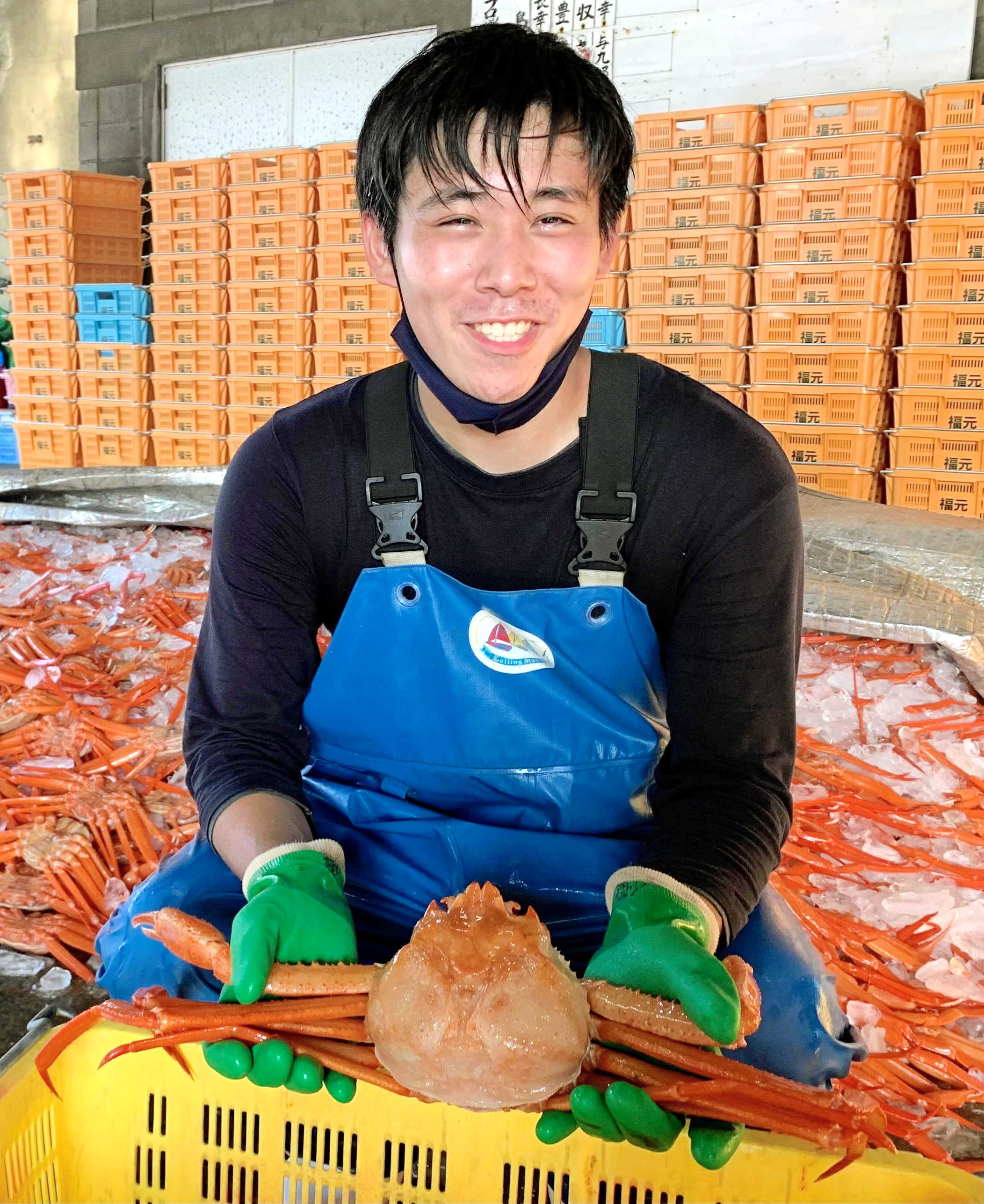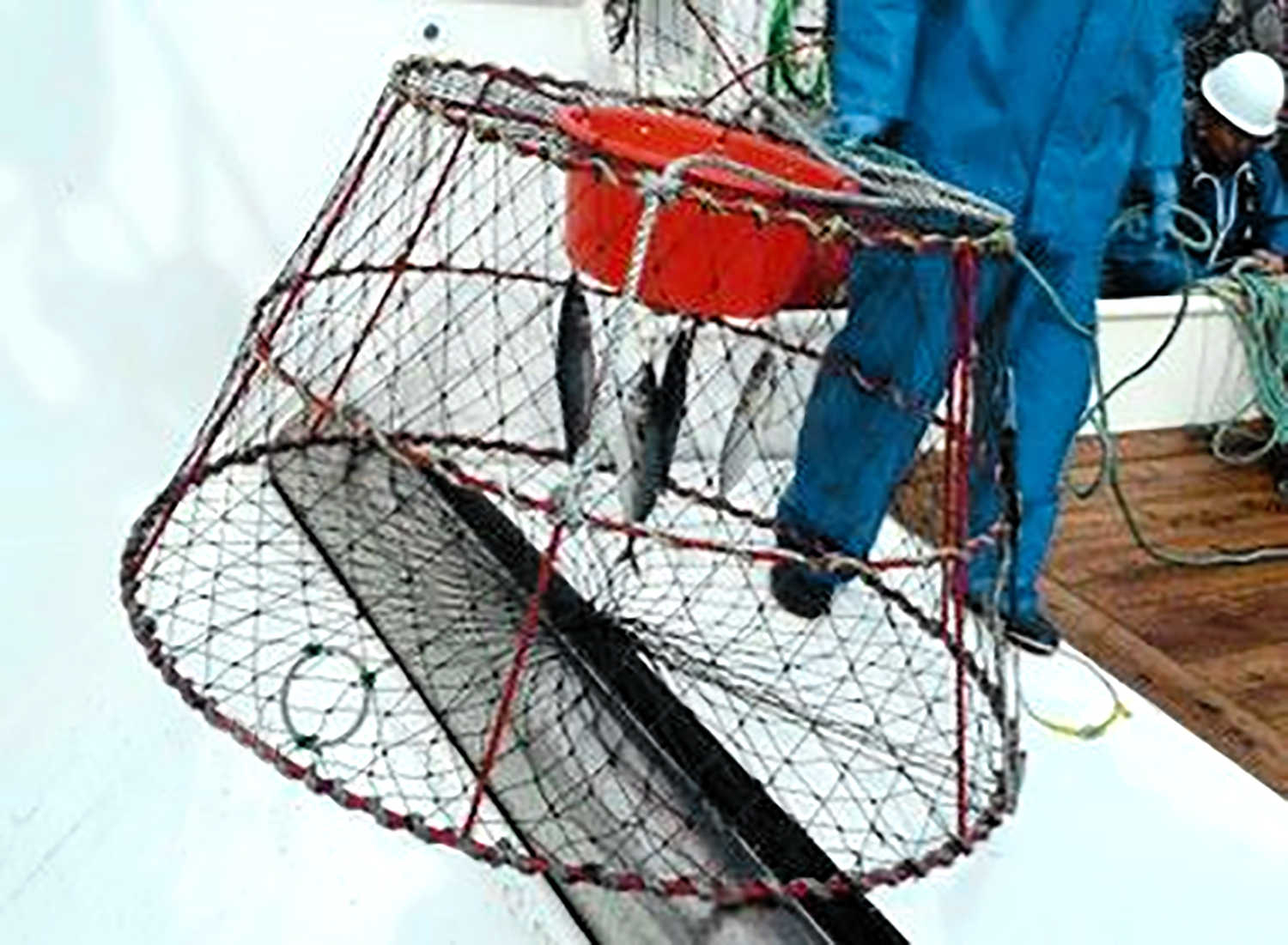Red Snow Crabs Vivid Vermillion Blessings From the Deep
At 4:30 PM, as the sun begins to set, Kasumi fishing port in Kami Town, Hyogo Prefecture begins to haul in their catches of red snow crabs. The vermilion color of the crab's body becomes even more vivid in the setting sun. Known as the "red jewel of the deep," this crab is caught only in Kasumi in the Kansai region and is marketed as "Kasumi crab.” Hyogo is full of stories of its diverse culinary “terroir”. In this article, we dive deep into the world of snow crabs, whose unique sweetness can be savored throughout both spring and summer alike.
Up to 2700 Meters Under the Sea

Yuta Fukumoto says, "Nothing feels as good as a good crab haul”
One large boat and eight smaller boats sail out from Kasumi to fish for red snow crab. The Fukumoto Yuta is the newest of the smaller boats, and its tank is packed full of vermilion crabs on ice. Yuta Fukumoto, who has been crab fishing for three years, smiles and says, "This is the best catch of the season.”
The shape and size of the body is almost the same as that of the Matsuba crab (a male snow crab), but the major difference, apart from the color, is the depth of the water in which they live. Snow crabs can be found anywhere from 200 to 500 meters, while the red snow crab is found deeper from 500 all the way down to 2,700 meters.
In addition, while ships in Tajima ports catch Matsuba crabs from November to March, the red snow crab, abundant in nature, can be caught for a longer period of time from September to May. Restaurants and roadside stations around Kasumi and Amarube Stations on the JR San-In Line hold "Kasumi Crab Lunch Fairs" in conjunction with the crab fishing season.
Caught off Tajima Coast, The Birth of a Name
Although found living in the Sea of Japan and around Hokkaido, snow crabs were only first caught as early as the 16th century, and it was not until the 20th century that red snow crabs were even known to exist.
Tajima is also where the name "red snow crab" was born. In 1950, Koji Yamamoto of the Japan Sea National Fisheries Research Institute, which had a test site in Kasumi, named one of the crabs collected off the Tajima coast. Later on, the term "red snow crab" spread and became common use.
Fisherman use a special way to catch deep-sea crabs. Because of the technical difficulty of using a conventional trawl net to catch snow crabs, cages like the one shown in the photo are dropped to the seafloor. Crabs are then lured in by hanging mackerel at the entrance of the cage. A group of around 200 traps spaced about 60 meters apart and strung together on a rope is called an "ichiren," or string, and can be as long as 10 kilometers.

A cage with a ring (see marked area) to release small snow crabs (courtesy of Tajima Fisheries Technology Institute)
Ensuring Freshness and Live Crab Distribution

A catch of snow crabs, Kasumi Fishing Port, Kami Town, Hyogo Prefecture
One challenge of crab fishing is that crabs tend to lose their freshness easily. Crabs live in near-zero temperature waters and, apart from winter, the warm currents on the surface of the Sea of Japan and the temperature outside the ocean when they are pulled up creates a harsh environment that can be near scalding to the catch. “September is particularly harsh with temperatures above 30 degrees Celsius during the day," says Toshiyuki Sawada, manager of the sales section of the Tajima Fisheries Cooperative's Kasumi Branch Office. For this reason, many crabs are boiled while they are still fresh for processing.
Red snow crab is also caught in Tottori, Toyama, and Hokkaido, but what makes Kasumi unique is that the crabs are carefully handled and distributed as "live" crabs when they are still alive at the time of catch.
Rare “Golden Crabs” Too
The small boats that make day trips are equipped with cold-water tanks to take advantage of the region’s ability to bring crabs to port in a short period of time after being caught, and to keep them alive. The tanks also contain a rare hybrid crab called the "golden crab.” It occurs naturally in waters where both snow crabs and red snow crabs live and has a light vermilion color. It is popular as a crab that combines the richness of snow crab and the sweetness of red snow crab. “Most of the live golden and red snow crabs are distributed in Tokyo and the Kyoto-Osaka-Kobe area, but locally, we also provide sashimi and other dishes," says Sawada.
A Model for Natural Resource Conservation
Efforts to protect natural resources are also underway in Hyogo. First, in 2005, the fishery began a voluntary June closure. In 2008, an escape ring 10 cm in diameter was attached to each trap net to allow smaller crabs to escape. In 2011, the number of rings was increased to two. Tetsuya Otani of the Hyogo Prefectural Tajima Fisheries Technology Institute explains why it’s important to find ways to avoid catching small crabs, “It takes time for them to mature, so once you deplete the natural resource, it will take a long time to recover.”
The results from these efforts have been remarkable. The percentage of crabs with a shell width of 12 cm or more has increased, and the catch per ichiren, or string, has more than doubled since the start of implementation. The number of fishing trips has been reduced to one-third of what it used to be, and the fishery is becoming able to catch large, high-value crabs more efficiently. Otani boasts, "I think that the red snow crab is a perfect model of successful cooperation between the fishing industry and testing and research institutes in resource management.”
In terms of species caught in the Sea of Japan off the coast of Tajima, snow crab is second only to the firefly squid. Both are deep-sea fishery products that, until recently, were unfamiliar to the Kyoto-Osaka-Kobe area. While the number of fish in the surrounding waters has been declining, efforts to maintain freshness, develop sales channels, and protect resources have made them staples of Tajima's fisheries.
We hope the trend to revitalize Tajima's rich sea while protecting the bounty of the deep, which supports the fishing industry, will continue to spread.
Written by Kazuyoshi Tsujimoto, Manager of Corporate Planning Department, Senior Staff Writer at The Kobe Shimbun (Daily Newspaper)
This article was first published on 25th September 2022 in The Kobe Shimbun as part of a series entitled "Wind, Water and Earth...Hyogo's Terroir"
Date : 2024.05.29




